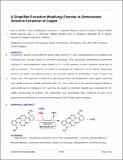A simplified extractive metallurgy exercise to demonstrate selective extraction of copper
Abstract
A laboratory activity is described for senior high school or 1st year undergraduate level students that illustrates key concepts linked to extractive metallurgy. This experiment demonstrates preferential binding of a methoxyphenolic oxime ligand to Cu2+ in the presence of other transition metal ions in aqueous solution. The students are tasked to investigate the importance of the spatial relationship between the oxime and phenol group of two potential ligands by performing a series of short and simple tests. The objective is achieved by identifying which methoxyphenolic oxime ligand selectively and rapidly forms an isolable precipitate with Cu2+ ions. Only one of the potential ligands exhibits a clear preference for binding to Cu2+ and this can easily be identified visually (and confirmed by UV-visible spectroscopy if desired). The experiment has successfully been employed as part of an extracurricular laboratory course involving groups of 25-30 high school students.
Citation
Smellie , I , Abdelhamid , Y , Carpenter-Warren , C L , Cordes , D B , Elliott , C , Lamorte , S , Patterson , I , Sanders , W , Sandison , I P , Slawin , A M Z , Stewart , D M & Walters , S N 2020 , ' A simplified extractive metallurgy exercise to demonstrate selective extraction of copper ' , Journal of Chemical Education , vol. 97 , no. 4 , pp. 1203-1207 . https://doi.org/10.1021/acs.jchemed.9b00996
Publication
Journal of Chemical Education
Status
Peer reviewed
ISSN
0021-9584Type
Journal article
Collections
Items in the St Andrews Research Repository are protected by copyright, with all rights reserved, unless otherwise indicated.

